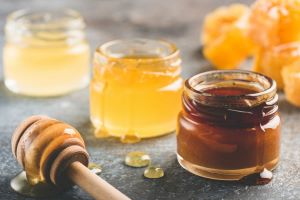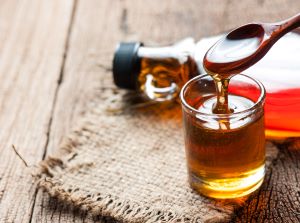If you are producing, collecting, or creating food products that you plan to package and sell, there are specific labeling requirements that you must follow. Use the dropdown menu below for labeling details about specific prepackaged food items that the MDA regulates. If you do not see your food item, further information is available on the U.S. Food and Drug Administration Food Labeling Guide webpage. The FDA Code of Federal Regulations and the Minnesota Food Code require prepackaged food available for self-service to be labeled with:
- the identity (name of food)
- net quantity of contents
- ingredient list - including major food allergens
- business name and address
- nutrition facts
Additional information on labeling can be found on the Food Labeling for Retail Food Establishments fact sheet or at FDA's Nutrition, Food Labeling, and Critical Foods website.
Prepackaged Foods: Per the Minnesota Food Code, "Packaged" means bottled, canned, cartoned, bagged, or wrapped, whether packaged in a food establishment or a food processing plant. Packaged does not include food delivered to a consumer by a food business employee, upon consumer request, that is wrapped or placed in a carry-out container to protect the food during delivery to the consumer.
Bulk Foods: Per Minnesota Statutes, "Bulk food" means unpackaged and unwrapped food in aggregate containers from which quantities are withdrawn by the consumer, excluding fresh fruits, fresh vegetables, nuts in the shell, and food in salad bars.
Approved Source: Per the Minnesota Food Code, "Approved" means acceptable to the regulatory authority based on a determination of conformity with principles, practices, and generally recognized standards that protect public health. A seller must purchase food from commercial suppliers under regulatory control which may include local, regional, or international growers, food manufacturing plants, food suppliers or distributors.
Food Additive: Title 21 of the Federal Food, Drug & Cosmetic Act defines “additive” as a substance with which the intended use results or may reasonably be expected to result, directly or indirectly, in it becoming a component or otherwise affecting the characteristics of any food. More information can be found in Title 21 of the Federal Food, Drug & Cosmetic Act for exceptions and further guidelines.
Allergen: Currently, there are eight major foods that account for 90 percent of all food allergies. They are: peanuts, tree nuts (almonds, pecans, walnuts, etc.) crustacean shellfish (crab, lobster and shrimp), fish, eggs, milk, soy, and wheat.
Consumer Advisory: Minnesota Statutes require food establishments to use a consumer advisory whenever raw or undercooked animal food is served or sold raw, undercooked, or without further processing to eliminate pathogens. Your consumer advisory must include a disclosure and a reminder. A disclosure is a written statement that clearly identifies the raw or undercooked animal food or item that contains a raw or undercooked ingredient. A reminder is a written statement that eating raw or undercooked food is associated with increased risk of foodborne illness. The reminder must include an asterisk by the item and a footnote.
Reduced Oxygen Packaging: Per the Minnesota Food Code, the package must be prominently and conspicuously labeled on the principal display panel in bold type on a contrasting background, with instructions to:
- maintain the food at 41 degrees F (5 degrees C) or below
- discard the food if within 30 calendar days of its packaging it is not served for on-premises consumption, or consumed if served or sold for off-premises consumption
- limits the refrigerated shelf life to no more than 30 calendar days from packaging to consumption, except the time the product is maintained frozen, or the original manufacturer's "sell by" or "use by" date, whichever occurs first

These instructions apply to liquid and comb honey only, not processed honey, which has all the requirements of processed food.
Principal Display Panel
The principal display panel must be large enough to clearly accommodate all required label information without crowding or obscuring designs. All information on the label must be prominent and conspicuous, but in no case may the letters and numbers be less than 1/16 inch high.
Product identity must be on the label, i.e., honey. The declaration of the floral source of honey on the label is not required. However, the name of the plant or blossom can be included if the information to support the conclusion that the plant or blossom designated on the label is the main floral source of the honey. Names such as “Clover Honey” or “Wildflower Honey” are acceptable.
The net quantity of contents must be expressed in terms of weight or measure. This declaration of contents must be expressed both in ounces and full unit if one to four pounds, or one pint to one gallon. The metric equivalent is sometimes required. The declaration must be in the lower one-third of the label separated from all other print. If the weight is more than one pound, fractions of a pound are expressed as a decimal, e.g., 1 1/2 pounds is 1.5 lb. The declaration must be in letters and numbers in a type and size relative to the area of the label panel of the package as follows:
- Not less than 1/16 inch in height for a label of five square inches or less.
- Not less than 1/8 inch in height for a label of more than five square inches but less than 25 square inches.
- Not less than 3/16 inch in height for a label more than 25 square inches.
To convert ounces to grams multiply by 28.4 and round off to grams. To convert pounds to grams multiply by 454.
Information Panel
The information panel must include the name and place of business, all ingredients and, when applicable, nutrition information.
A complete list of ingredients, if other than honey, including standardized food products, must be on the label in order of predominance by weight if there are two or more ingredients. All artificial colors must be specifically listed. Include the business name, and address (including zip code) on the label.
If health or nutritional claims are made on a food label, the product is subject to special nutritional labeling.
General Information
All labeling must be truthful and accurate. Food standards must not be violated.
The U.S. Grade is voluntary on honey labels and is offered as a fee for service by the U.S. Department of Agriculture Agricultural Marketing Service. Grade is primarily assessing the moisture and color. Grade A = 18.6 percent moisture and freedom from defects (no foreign material) if filtered. If a Grade is used, the Grade must be accurate and must declare the country of origin.
Although not required by regulation, a warning statement is common on honey indicating “Do not feed to infants under one year of age” due to naturally occurring Clostridium botulinum spores present in some honey which can be fatal for some infants as they cannot adequately digest it.
Many products have exemptions or further requirements to the above label regulations.

These instructions apply to pure maple syrup only.
Principal Display Panel
The principal display panel must be large enough to clearly accommodate all required label information without crowding or obscuring designs. All information on the label must be prominent and conspicuous, but in no case may the letters and numbers be less than 1/16 inch high.
Product identity must be on the label, i.e., maple syrup. The net quantity of contents must be expressed in terms of weight or measure. This declaration of contents must be expressed both in ounces and full unit if one to four pounds, or one pint to one gallon. The metric equivalent is sometimes required. The declaration must be in the lower one-third of the label separated from all other print. If the weight is more than one pound, fractions of a pound are expressed as a decimal, e.g., 1 1/2 pounds is 1.5 lb. The declaration must be in letters and numbers in a type and size relative to the area of the label panel of the package as follows:
- Not less than 1/16 inch in height for a label of five square inches or less.
- Not less than 1/8 inch in height for a label of more than five square inches but less than 25 square inches.
- Not less than 3/16 inch in height for a label more than 25 square inches.
To convert ounces to grams multiply by 28.4 and round off to grams. To convert pounds to grams multiply by 454.
Information Panel
The information panel must include the name and place of business, all ingredients and, when applicable, nutrition information.
Include the business name, and address (including zip code) on the label.
A complete list of ingredients, if other than maple syrup, must be on the label in order of predominance by weight if there are two or more ingredients. All artificial colors must be specifically listed. De-foaming agents may be used as a processing aid during manufacture. The de-foaming agents, when used properly in that they are used in insignificant quantities and having no function in the finished maple syrup, do not need to be declared in the ingredient list. The addition of sweeteners or other substances to the syrup no longer meets the standard of identify for pure maple syrup and cannot be labeled as such.
If health or nutritional claims are made on a food label, the product is subject to special nutritional labeling.
General Information
All labeling must be truthful and accurate. Food standards must not be violated.
The U.S. Grade is voluntary on maple syrup labels and is offered as a fee for service by the U.S. Department of Agriculture Agricultural Marketing Service. The grading system references the color, taste, and percent solids. For more information, visit the USDA’s Maple Syrup Grades and Standards webpage.
Many products have exemptions or further requirements to the above label regulations.

These instructions apply to wild rice only, not processed, which has all the requirements of processed food. The harvesting of wild rice is a regulated product. Refer to the Minnesota Department of Natural Resources for more information on harvesting wild rice.
Minnesota Statues on Wild Rice Labeling contain specific language for labeling wild rice which is summarized below.
Principle Display Panel
The principal display panel must be large enough to clearly accommodate all required label information without crowding or obscuring designs. All information on the label must be prominent and conspicuous, but in no case may the letters and numbers be less than 1/16 inch high.
Product identity must be on the label, i.e., wild rice. Wild rice containing a portion of cultivated wild rice, grown under regulated conditions in man-made paddies, and offered for wholesale or retail sale in Minnesota must be plainly and conspicuously labeled as either ‘paddy’ or as ‘cultivated’.
A package of wild rice containing only 100 percent natural lake or river wild rice, meaning harvested from the wild in lakes and rivers, that is offered for sale at wholesale or retail sale in Minnesota must be plainly and conspicuously labeled as "100 percent naturally grown, lake and river wild rice". It must also contain the license number required per Minnesota Statutes of the last licensed dealer, if any, who handled the wild rice.
If a package of wild rice contains a portion of 100 percent naturally grown lake and river wild rice that is harvested by use of mechanical harvesting devices, it must be plainly and conspicuously labeled as "machine harvested". In addition, the letters "machine harvested" must be placed near the product's identity on the label. Packages containing 100 percent hand-harvested wild rice may be labeled as "hand-harvested."
A package of cultivated or natural lake or river wild rice offered for sale must specify the place of origin of the wild rice placed near the product's identity on the label. Only packages containing cultivated or natural lake or river wild rice that is 100 percent grown in Minnesota may be labeled as "grown in Minnesota."
The net quantity of contents must be expressed in terms of weight or measure. This declaration of contents must be expressed both in ounces and full unit if one to four pounds, or one pint to one gallon. The metric equivalent is sometimes required. The declaration must be in the lower one-third of the label separated from all other print. If the weight is more than one pound, fractions of a pound are expressed as a decimal, e.g., 1 1/2 pounds is 1.5 lb. The declaration must be in letters and numbers in a type and size relative to the area of the label panel of the package as follows:
- Not less than 1/16 inch in height for a label of five square inches or less.
- Not less than 1/8 inch in height for a label of more than five square inches but less than 25 square inches.
- Not less than 3/16 inch in height for a label more than 25 square inches.
To convert ounces to grams multiply by 28.4 and round off to grams. To convert pounds to grams multiply by 454.
Information Panel
The information panel must include the name and place of business, all ingredients and, when applicable, nutrition information.
A complete list of ingredients, if other than wild rice, including standardized food products, must be on the label in order of predominance by weight if there are two or more ingredients. Include the business name, and address (including zip code) on the label.
If health or nutritional claims are made on a food label, the product is subject to special nutritional labeling.
General Information
All labeling must be truthful and accurate. Food standards must not be violated.
American Indian harvested or processed wild rice must be 100 percent natural lake or river wild rice harvested by American Indians.
Wild rice labels labeled with Minnesota grown must be 100 percent grown within the boundaries of the state of Minnesota.
Many products have exemptions or further requirements to the above label regulations.
If you are selling eggs from your own flock, more information can be found on the Egg Handling and Sales of Shell Eggs webpage.

